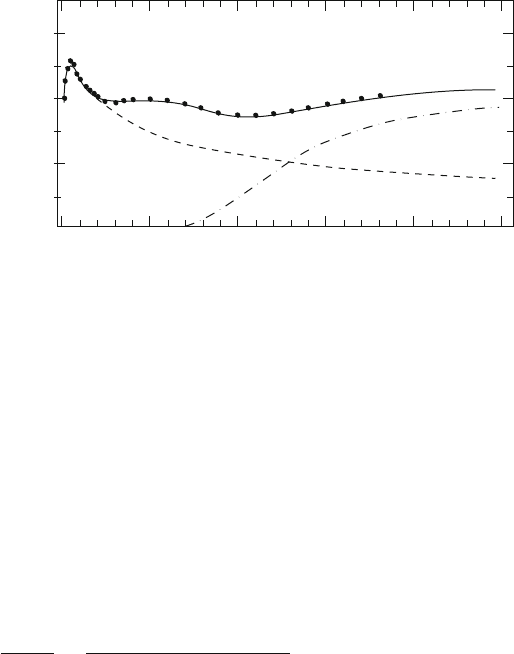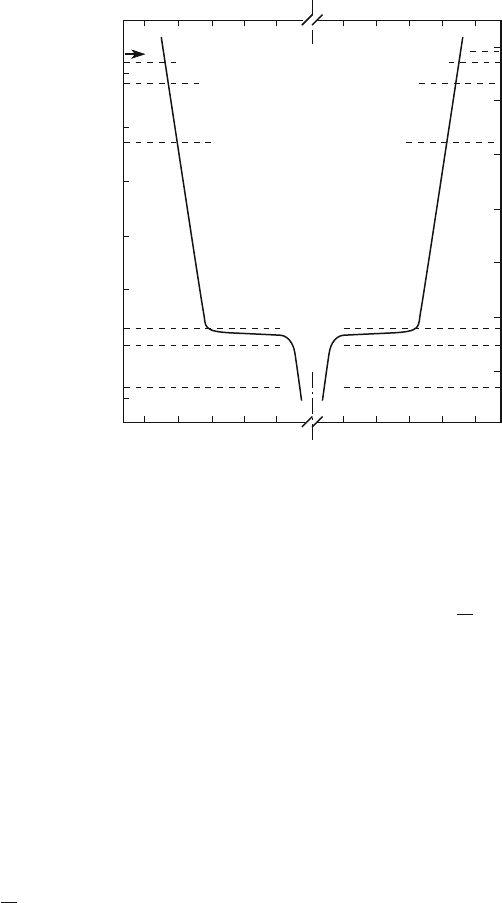Braibant S., Giacomelli G., Spurio M. Particles and Fundamental Interactions: An Introduction to Particle Physics
Подождите немного. Документ загружается.


402 13 Microcosm and Macrocosm
energy electron bremsstrahlung or inverse Compton). A clear evidence for
the presence of hadronic processes in astrophysical objects (the “smoking
gun” for the discovery of CR sources) could only come from the observation
of neutrinos from the decay of charged pions. The detection of high energy
neutrinos and antineutrinos is mandatory for a comprehensive understanding
of many astrophysical processes taking place in our Galaxy and particularly
extragalactic objects such as AGNs and those cosmic objects that give rise to
gamma-ray bursts (GRBs).
The small cross-section is the reason for the modest neutrino attenuation
in crossing the dense layers around the astrophysical objects where they
are produced. Neutrinos reach the Earth after traveling enormous galac-
tic/intergalactic distances. A 100 GeV neutrino has a cross-section of 6:7
10
7
b, which means that it can travel on average through a thickness of
24 million km of water before undergoing an interaction. The small neutrino
cross-section requires the use of huge detectors, for example, those consisting
of a large volume of water (sea or lake) or even ice. It is estimated that an
instrumented volume of about 1 km
3
of ice or water is needed to be sensitive
to the neutrino flux from a cosmic source.
The most efficient way to search for astrophysical neutrinos is through the
detection of charged current interactions of muon neutrinos, with a muon in
the final state. The muon is the particle with the longest range (Chap.2): a
200 GeV muon can travel about one kilometer of water. Moreover, at high
energies, the muon essentially retains the original direction of the neutrino
(the average deflection angle is less than 0:1
ı
for 1 TeV neutrino). A detector
measuring the muon direction can therefore be used to trace back the
emission source.
The is detected trough the Cherenkov light produced when the relativistic
particle crosses a transparent and dense medium, as deep sea water or deep
ice. A suitable array of photomultiplier tubes (PMT) can be used for the detec-
tion of photons emitted by the muon; from the PMT positions and photon ar-
rival times, dedicated algorithms can trace back the muon direction. Only up-
ward going muons are unambiguously originated from neutrino interactions.
Neutrinos (in association with charged leptons) produced by CR interactions
with atmospheric nuclei represent an irreducible background for cosmic
neutrinos. Even if a detector is located under 2–3 km of water/ice, the number
of muons produced by cosmic ray interactions in the atmosphere above the
detector is overwhelming by more than five orders of magnitude than that
produced by atmospheric neutrinos. Unlike traditional astronomy, neutrino
astronomy examines the sky underground, on the other side of the Earth!
A neutrino telescope buried under the Antarctic ice is almost completed
(2010); this telescope will study the northern hemisphere sky. To observe
the southern celestial hemisphere (where the galactic center is located,
with its potentially interesting sources), the construction of a 1 km
3
-scale

13.5 Dark Matter 403
neutrino telescope in the Mediterranean Sea is planned in the next few years.
The ANTARES neutrino telescope near the French coast is a smaller scale
experiment (1=50 km
3
) in operation since May of 2008.
Particles and cosmology. The study of the dynamics of the stars in the galac-
tic halos and of galaxies in galaxy groups showed that the quantity of matter
in the Universe must be much larger than that observed with astronomical
instruments. Matter which does not produce any electromagnetic radiation is
denoted as dark matter; its nature is still unknown. It is likely that a part of the
dark matter consists of celestial bodies like the planet Jupiter and gas clouds
(baryonic dark matter); another part could consist of a “gas” of cold, weakly
interacting and massive particles, see Sect. 13.5.
The knowledge of the fundamental interactions between particles is needed
to understand the dynamics of the first moments of the Universe (Sect. 13.6).
As a result of what happened in the early moments, different types of “relic”
particles may be now present in the Universe (as for the case of magnetic
monopoles, Sect. 13.1.2). After the phase transition corresponding to the
formation of atoms (about 300,000 years after the Big Bang), the decoupling
of electromagnetic radiation and matter took place. The Universe is uniformly
filled with a microwave electromagnetic radiation, the cosmic microwave
background, with a frequency spectrum typical of that of a 3 K blackbody
radiation [W08].
Similarly, about 1 s after the Big Bang, the decoupling of neutrinos from
the rest of matter and radiation occurred. These relic neutrinos should
have a temperature of about 2 K and the density number would be about
300 cm
3
(50 for each neutrino and antineutrino type). Relic neutrinos are
not currently observable. As discussed in Sect. 12.9, cosmology allows one
to set upper limits to the neutrino masses. Neutrinos with a very small mass
should be distributed almost uniformly in the Universe; on the contrary, if
the mass is of the order of a few eV, they would form halos around galaxy
groups. This has consequences regarding the dynamics of galaxy formations,
and the limit on the mass is derived from the observed distributions.
13.5 Dark Matter
The Universe is observed using electromagnetic waves of different frequencies
emitted by celestial bodies (in the optical band first, then in the radio, infrared,
X-rays and -rays). It is very likely that a majority of the matter in the Universe
does not emit electromagnetic radiation. The existence of this invisible matter, the

404 13 Microcosm and Macrocosm
dark matter (DM), was indirectly highlighted through its gravitational interaction
with ordinary matter, which emits electromagnetic radiation.
Evidence for the existence of dark matter in spiral galaxies emerges from the
analysis of the revolution speeds of stars and gas clouds in the galactic halo as a
function of the distance from the center of the galaxy. Spiral galaxies, like our own
galaxy, contain 10
11
stars, arranged in the form of a central nucleus and a flattened
rotating disk. The revolution speed of a mass m star around the center of the galaxy
is determined by the condition of stable orbits, equating the gravitational force with
the centrifugal force, that is,
G
N
mM
r
r
2
D
mv
2
r
(13.17)
from which:
v.r/ D
r
G
N
M
r
r
: (13.18)
M
r
is the total mass of stars and interstellar material within the distance r from the
center of the galaxy. Most of the stars of a spiral galaxy are located in the central
spherical bulge with radius r
s
.If is the average density of stars in the bulge, we
have M
r
D
4
3
r
3
for r<r
s
; it follows that
v.r/ D
r
4
3
G
N
r r for r<r
s
: (13.19a)
If all the galaxy mass is assumed inside the bulge, then M
r
' constant for r>r
s
,
and
v.r/ 1=
p
r for r>r
s
: (13.19b)
The observed matter distribution in the bulge and disk leads to a revolution speed of
the stars as shown by the dashed line in Fig. 13.8 for the spiral galaxy NGC3198. The
figure also shows the contribution of a possible dark matter halo. The experimental
data obtained using the Doppler effect are indicated with black dots. From the figure
it is evident that at high r, the measured velocities v ' 200 km s
1
are larger than
those obtained using (13.18), also including the additional contribution of stars in
the disk. There must be a contribution from a halo of dark matter. Similar results are
obtained by measuring the speed of stars in other spiral galaxies. Evidence for the
presence of dark matter also exists for elliptical galaxies and for galaxy clusters.
One of the major achievements of “experimental cosmology” is the series of
precision measurements of cosmic microwave background (CMB). In 1992, the
COBE satellite measured the black body spectrum (at a temperature of 2.725K)
of the background radiation. The measurements confirmed that any deviation
from a Planck curve was smaller than 1/10,000, as expected (J.C. Mather and
G.F. Smoot, Nobel laureates in 2006). The deviations from a perfect black body

13.5 Dark Matter 405
0510
100
0
200
300
15 20 25
v (km s
–1
)
r (kpc)
halo
bulge
+ disk
Fig. 13.8 The points indicate the measured rotation speeds of stars in the spiral galaxy NGC3198,
versus their distance r from the galactic center. The dashed line represents the expected
contribution based on the visible matter in the galactic nucleus (bulge) and in the galactic disk;
the dotted-dashed line includes the contribution of a halo of dark matter. The solid line is a fit to
experimental data assuming visible matter in the bulge and disk and dark matter in the halo
spectrum were measured with experiments placed on balloons (BOOMERanG
[13B00], MAXIMA). Recently, the WMAP experiment on a satellite measured the
temperature differences in the CMB radiation with high precision. The measured
anisotropies are used to estimate the Universe’s geometry, content, and evolution;
test the Big Bang model and the cosmic inflation theory. Cosmology closely
connects the curvature of the Universe with its matter density ˝ D =
c
,where
c
is the critical density of the Universe:
c
D
3H
2
8G
N
D
3.100 h
0
km s
1
Mpc
1
/
2
8G
N
' 1:9 10
29
h
2
0
gcm
3
(13.20)
where H D 100h
0
km/s/Megaparsec is the Hubble constant, h
0
' 0:71.
The recent WMAP results have shown that (1) the Universe is 13.7 billion years
old (with 1% margin of error); (2) the cosmological scenario which includes a period
of cosmic inflation is in agreement with the observations; (3) the Hubble constant is
H D 100h
0
D 71 ˙ 4 km/s/Megaparsec; (4) ˝
tot
D 1.
In particular, the matter density ˝ can be expressed as the sum of different
density terms:
1. Visible baryonic matter: ˝
vis
' 0:005:
2. Nonvisible baryonic matter: ˝
b
' 0:046:
3. Nonbaryonic dark matter: ˝
DM
0:23:
4. (from which neutrinos: ˝
0:003 0:1/:
5. “Quintessence”(dark energy) ˝
Q
0:72:
406 13 Microcosm and Macrocosm
The “Quintessence” (or dark energy) is still an unknown form of energy that
permeates the space and tends to increase the expansion rate of the Universe. We
will return to this topic at the end of this chapter.
No experiment has ever provided direct information on the nature of dark matter.
The baryonic fraction of DM could be astrophysical bodies in their terminal phase
(remnants) as white dwarfs, neutron stars and black holes. They could also be
smaller objects, with insufficient mass (0.1 m
ˇ
,wherem
ˇ
indicates the mass of
the Sun) to become stars (Jupiter-like planets); these massive compact objects are
called MACHO. The research in galactic halos (via effects like gravitationallensing)
indicates that such objects with m < 0:1m
ˇ
exist, but that their total mass is much
smaller than that of the dark matter halo. MACHOs are probably not important at
the cosmological level, and they are almost certainly negligible even at the level of
the internal dynamics of galaxy structure and formation.
There are other arguments in favor of the existence of nonbaryonic DM. For
example, the study of nucleosynthesis of light nuclei at the cosmic time t ' 200 s
leads to the value ˝ < 0:02 if only baryonic matter is considered. It is noteworthy
that without nonbaryonic DM, it is difficult to construct models of galaxy formation
starting from small fluctuations, like those observed in the cosmic microwave
background. The nonbaryonic DM could be a gas of weakly interacting particles,
classified as hot or cold particles depending on whether they were relativistic or not
at the time of galaxy formation. If these DM particles are in thermal equilibrium with
baryons and radiation, they are classified as hot or cold DM if their mass is smaller
or larger than 1 keV, respectively. Models with cold DM are better reproducers of
the observed large scale structure of our Universe.
An interesting candidate for cold DM is the stable SUSY particle, the lightest
neutralino, with a mass of the order of 100 GeV; it manifests itself as a Weakly
Interacting Massive Particle (WIMP). A WIMP can be directly detected through
elastic interaction with nuclei in scintillators, solid state detectors, etc.; the recoil
nucleus will deposit a few keV of energy large enough to be measured.
There is currently a continuous development of larger and more sophisticated
detectors (particularly cryogenic detectors) that can provide accurate measurements
of temperature rise due to WIMP energy loss by ionization or excitation. The main
problem is to distinguish genuine WIMPs interaction from background due to the
ambient radioactivity. To unambiguously distinguish a possible WIMP signal from
the background, the DAMA experiment [13B08] at the Gran Sasso Laboratory
exploits the peculiarities of the “wind” which produces a WIMP annual modulation.
Our galaxy should be surrounded by a WIMPs halo and our solar system (which is
moving at a speed of about 230 km/s compared to the galactic system) should be
continuously hit by a WIMPs “wind.” As the Earth moves around the Sun, the flux
of WIMPs, if any, should be maximum in June (when the revolution speed of the
Earth adds to the speed of the solar system in the galaxy) and minimum in December
(when the two velocities have opposite directions). Data collected for 7 years
suggest the presence of an annual modulation. This modulation can be explained
by a contribution of WIMPs with mass of about 10 GeV. Other experiments (using
different experimental techniques) do not confirm this signal, but the discussion is
still open.
13.6 The Big Bang and the Primordial Universe 407
WIMPs are also searched for by using indirect methods: massive WIMPs can
be slowed down by elastic collisions and captured by a celestial body (like the
Earth or the Sun). If WIMPs collect in the nuclei of these celestial bodies, a higher
concentration is expected, and WIMP–antiWIMP annihilation can take place. This
annihilation would produce particles that decay into high energy
that could be
detected in large underground detectors and in neutrino telescopes, resulting in high
energy muons from
N !
C X, with direction coming from the center of the
Earth (or the Sun).
Another searched particle is the axion,that is, a particle theoretically predicted
in models beyond the SM whose mass should be 10
5
eV. Axions would be
nonrelativistic even if they have low mass. They are searched through their
conversion into photons in a nonuniform magnetic field.
13.6 The Big Bang and the Primordial Universe
According to the Big Bang model, the expansion of the Universe originated
from a “primordial explosion,” from a space-time singularity of very high density
and temperature. Starting from the Big Bang, the Universe can be considered
as a gas of particles rapidly expanding. Our knowledge on particle physics,
fundamental constituents and interactions, helps us to understand what probably
happened. Theories on the unification of fundamental interactions have been
applied to describe the evolution of the Universe immediately following the
Big Bang.
To imagine the nature of the expansion, the example of the swell of a balloon
is used. Inflating the balloon, the distance between any pair of points drawn on its
surface increases. A hypothetical two-dimensional observer located at one point on
the balloon surface would see all other points moving away from his position in all
directions. Other observers on the balloon surface will observe the same recession.
There is no privileged point: the expansion has no center within the two-dimensional
surface. For two-dimensional observers on a spherical surface, the Universe is finite
and unrestricted in the sense that a flat individual can move in a fixed direction
and, continuing, will return to the starting point. According to general relativity, the
Universe expansion happens in four dimensions; it is difficult for us to see the fourth
dimension, as it is difficult for the two-dimension observers to visualize their third
dimension.
The Big Bang model is mainly based on three experimental facts: (1) the
recession of galaxies; (2) the cosmic microwave background and (3) the ratio of
helium–hydrogen abundance.
Cosmic microwave background radiation. The Universe is uniformly filled with
a cosmic microwave background radiation generated at the time of H and He atoms
formation, when the temperature of the Universe had dropped to 4,000K (time of
atoms formation). As the radiation no longer had enough energy to further ionize the
408 13 Microcosm and Macrocosm
atoms, the Universe became transparent and from that moment, matter (i.e., atoms)
and electromagnetic radiation were independent. The corresponding present number
density of photons, about 400 cm
3
, represents the largest number of particles in
the Universe. When increasing time, the Universe expanded and cooled down to
its present status. The expansion causes an increase in the distance between two
successive wave crests. A longer wavelength corresponds to lower photon energy.
Helium abundance in the Universe. Direct observation indicates that the helium
present in every galaxy, in any direction and at any distance, corresponds to 20–24%
of the visible baryonic mass. This is explained assuming that helium (and other light
elements, for example, D;
3
He;
7
Li;
7
Be) was produced in the early moments of
the Universe. Heavier nuclei have been synthesized in heavy stars, see Sect. 14.10.
The picture of the Universe before the helium formation (200 s after the Big
Bang) was as follows: the temperature was about 10
9
K and a large number of
photons, a relatively small number of protons, neutrons and electrons were in
statistical equilibrium. A large number of neutrinos were also present, but with
negligible influence because of the low neutrino interaction cross-section with
matter. The interaction between neutrons and protons formed deuteron nuclei
with energy release; but deuteron were dissociated through C d collisions and
immediately split into their constituents n and p. When the temperature fell below
one billion degrees, the photon energy kT was no longer able to break the deuteron
nuclei. Then, a series of nuclear reactions undisturbed by the photons began; the
reactions led to the formation of helium, the more stable between light nuclei, and
of a relatively small number of other light nuclei elements. The time at which they
were produced is called the nucleosynthesis phase of light elements.
The evolution after the Big Bang. As for the above description of the nucleosyn-
thesis of light elements, the state of the Universe at any given moment is determined
by statistical mechanics laws. Additional information exists regarding the number
density of particles present, their temperature (i.e., their average kinetic energy),
and how they interact. This information can be obtained by making extrapolations
based on the knowledge of the interactions among particles at lower energies, and
assuming conservation laws. It is assumed that all the conserved physical quantities
(charge, baryonic and leptonic numbers, :::) were zero at the beginning. At some
point, during a phase transition, some process (yet unknown) which allowed the
matter to dominate over antimatter must have occurred.
We will show the evolution of the early moments of the Universe using a set
of “snapshots” taken at increasing times. We must remember that our knowledge
decreases when approaching the Big Bang. The broad outlines of the Universe
history, illustrated in Fig. 13.9 and described below, are clear, but perhaps many
“details” remain to be defined.
1. Cosmic time t
1
D 0, about 13.7 billion years ago. The Big Bang happens, i.e.,
the singularity at the origin of the Universe. From this moment, the Universe
expands. All conserved quantum numbers are equal to zero. Probably, the total
energy is also equal to zero because the kinetic energy, i.e., the energy of
motion, is equal and opposite to the gravitational potential energy.

13.6 The Big Bang and the Primordial Universe 409
Structures (Galaxies, galaxy clusters, ....)
Matter and radiation decoupling
Primordial nucleosynthesis
Quarks confinement
Quark gluon plasma
Inflation
GUTs
Quantum gravity
2.7
T (∞K)
10
5
10
10
10
15
10
20
10
25
10
30
10
+15
10
+40
10
+40
10
–40
010
–40
0
10
+5
10
–5
10
–15
10
–25
10
–35
10
–45
Radius (cm)
Present
Time (sec)
Fig. 13.9 One possible way to describe the evolution of the Universe: temperature (T ) and time .t/
versus the parameter R
0
that can be identified as the “radius” of the Universe. Note the inflationary
phase, when the Universe expanded exponentially
2. First phase transition at t
2
D 10
43
s (Planck time). The temperature is T
2
'
5 10
31
K; the average kinetic energy of each particle is E
2
' 10
19
GeV. It is
the moment when particles are generated. For times smaller than the Planck
time, quantum mechanical fluctuations did not allow one to consider particles
as separate entities and the gravitation was unified with the Grand Unified
interaction. Up to this moment, the emitted gravitational waves were absorbed;
from this time, they are free to propagate.
3. From 10
43
to 10
35
s. The Universe (if quarks and leptons are the ulti-
mate constituents of matter) is a gas of quarks and leptons, antiquarks and
antileptons, and of X; Y bosons, the mediators of the Grand Unification
interaction (if they exist). In this case, leptons and quarks behave like members
of the same family; a quark can transform into a lepton (or vice versa).
4. Second phase transition at t
4
' 10
35
s. The temperature is T
4
' 5 10
27
K,
E
4
' 10
15
GeV per particle. The era of the Grand Unification of the
strong with the electroweak interaction (from t
2
to t
4
) ends with a phase
transition. Transitions from a quark to a lepton (or vice versa) are no longer
possible. Interactions of quarks became very different from those of the leptons.
This is the GUT transition, during which new particles can be created, for
example, the magnetic monopoles.Att D t
4
,theelectroweak era started.
According to some models, the phase transition at t D t
4
began with a hyper-

410 13 Microcosm and Macrocosm
expansion (or inflation) of the Universe. Inflation is expected to have reduced
the number of magnetic monopoles, and made the Universe “flat,” isotropic
and causally connected. Inflation has increased with a superluminal speed at a
region of about 10
25
cm to 100 m in a very small fraction of time.
5. From 10
35
to 10
10
s. Strong and electroweak interactions are different,
and quarks and leptons behave as different objects; the X; Y bosons decay
into quarks and leptons. Their decay leads to an asymmetry between matter
and antimatter, with a slight predominance of the former. During this period
(electroweak era), it seems that nothing happens: it is a short time interval
that corresponds to a large energy range. Many physicists defined this time
interval as the desert. Maybe the desert will “flourish,” if new particles (e.g.,
supersymmetric particles) with masses of the TeV order are discovered.
6. Third phase transition at t
6
D 10
10
s. The temperature is T
6
' 1:5
10
15
K, E
6
' 200 GeV. The electroweak era ends: after this moment, the
electromagnetic and weak forces are different from each other.
7. Fourth phase transition at t
7
D 10
6
s. Particle–antiparticle annihilations
begin. As a result of q
q and e
C
e
annihilations, there is the disappearance of
antimatter, leaving a number (relatively limited) of quarks and electrons. Before
t
7
, there was a plasma of q; q, gluons (quark-gluon plasma), plus electrons.
8. Fifth phase transition at t
8
D 10
4
s. The temperature is T
8
D 1:5 10
12
K,
E
8
' 0:2 GeV. This phase transition corresponds to quarks confinement to
form baryons. Leading up to this moment, quarks are free particles. Now, u;d-
type quarks combine in triplets to form protons and neutrons (maybe also the
few remaining
q join in triplets to form p and n). The difference in the number
of quarks and antiquarks is now a difference between the number of p and
p
(and between n and
n).
9. From 10
4
to 1:1s. The Universe is dominated by particles with masses smaller
than 6 MeV: electrons, positrons, neutrinos, antineutrinos and photons. The
Universe is still so hot and dense that neutrinos interact quickly and are in
thermodynamic equilibrium with e;. Their abundances are almost equal. The
number of p and n is instead very small, about one in every billion of (or e
or ). The number of n is almost equal to that of p.
10. Sixth phase transition at t
10
D 1:1s. The temperature is T
10
' 1:4 10
10
K,
E
10
' 2 MeV; the neutrino decoupling happens. The average energy of
neutrinos, as that of any other particle, and the neutrino interaction probability
(cross-section) decrease; the matter density decreases as well with increasing
time. As a result, the neutrinos at t D t
10
do not interact frequently with the rest
of the matter and become independent.
The neutron has a mass slightly larger than that of the proton: this did not
play a role when the typical energies were high. In the collisions, a neutron
could transform into a proton with an equal probability than that for the reverse
reaction. The mass difference between n and p produces a difference in the
reaction probabilities at the kinetic energies of this period. Just before neutrino
decoupling, the reaction
e
n ! e
p was more likely than the reverse reaction.
There was therefore a relative increases in the number of protons. At t D 1:1 s,

13.6 The Big Bang and the Primordial Universe 411
there is about 24% of neutrons and 76% of protons. In a pn collision, a
deuterium nucleus can be formed: np ! d. The deuteron is rapidly broken
into its constituents by a photon interaction d ! np .
11. Seventh phase transition at t
11
D 4s. The temperature is T
11
' 4 10
9
K,
E
11
'0:5 MeV per particle: the e
C
e
pair annihilation begins. Photons have
an energy below the energy required to produce e
C
e
pairs. There is no
compensation for electron and positron losses due to their annihilation. The
e
and e
C
disappear rapidly, only a small number of electrons, the excess over
the e
C
, remains. The number of remaining electrons is exactly equal to that of
protons. The released energy in the annihilation process heats the particles that
are coupled together (photons, but not neutrinos). The photons reach an average
temperature 35% higher than that of neutrinos.
12. From 4 to 200 s. Positrons disappear from the Universe. The number of
neutrons relative to that of protons continues to decrease, due to their ˇ-decay
(n ! pe
e
). At this stage, the main components of the Universe are ; ;
with a (relatively) small percentage of e
;p;n (an electron/proton for every
billion photons.)
13. Eighth phase transition at t
13
' 200 s. The temperature is T
13
' 10
9
K,
E
13
' 140 keV per particle: it is the phase when the nucleosynthesis of
deuterium, helium and other light elements (which have already been discussed
above) takes place. From this moment, there is nuclear matter, with 24% helium
and 76% of protons (in weights).
14. From t
13
D 200 s to t
14
' 10;000 years. The Universe mainly contains pho-
tons and neutrinos. There is a (relatively) small amount of matter. There are
no more free neutrons. The radiation continues to cool down as well as matter.
Matter is in the form of a gas of electrically charged particles (protons and
electrons). A plasma of electrons and protons is the fourth state of matter (after
solid, liquid and gaseous states). It is still abundant today because it is the
dominant state inside the stars.
15. t
15
' 10; 000 years. Matter and radiation energy densities are equal:
mat ter
D
radiation
.Theradiation era, which had originated just after the Big Bang,
ends and the matter era (that continues today) begins. In the era of matter,
energy is dominated by matter, i.e., the energy associated with the rest mass
mc
2
. However, in the radiation era, the particle kinetic energies were much
higher than the energy associated with the mass. Atoms cannot form yet: if a
proton captures an electron to form a hydrogen atom, shortly after, a collision
with a photon breaks the binding.
16. Ninth phase transition at t
16
' 300;000 years. The temperature is T
16
'
4;000 K,
E
16
'0:5 eV per particle: this is the time of atom formation.The
photon energy is so low that photons are no longer able to break atoms.
In a relatively short time, electrons combine with protons to form hydrogen
atoms, and with helium nuclei to form helium atoms. As the photons are no
longer absorbed by atoms, the Universe becomes transparent to electromagnetic
radiation, which is now decoupled from the matter and has an “independent
